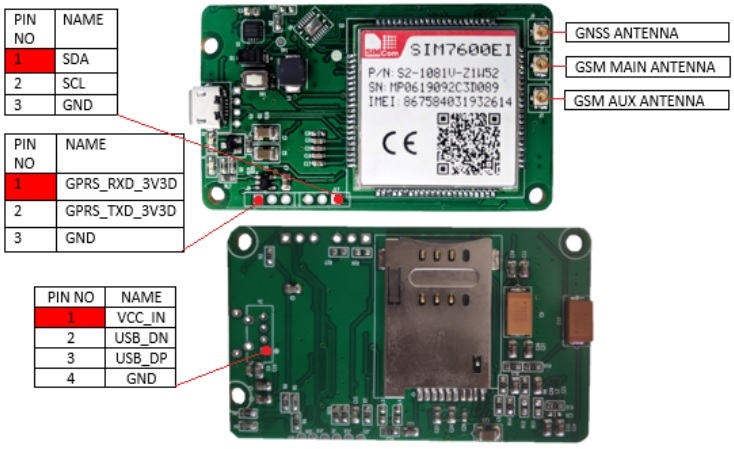
Overview
- SIM7600EI is a 4G LTE module manufactured by SIMCom, widely used in IoT and embedded applications including robotics, remote monitoring, and communication systems.
- It supports multiple communication standards including LTE, WCDMA, GSM, and GNSS (GPS, GLONASS, BeiDou).
Introduction to SIM7600EI
The SIM7600EI is a 4G LTE cellular communication module developed by SIMCom. It is designed to provide high-speed wireless data transmission and global positioning capabilities for embedded systems, IoT devices, and robotics platforms. The module supports multiple cellular standards and GNSS (Global Navigation Satellite System), making it a versatile choice for applications requiring reliable cellular connectivity and location tracking.
Technical Specifications
Network and Communication Standards
- 4G LTE: Supports LTE FDD and TDD bands, enabling high-speed internet access.
- 3G WCDMA: Backward compatibility with 3G networks.
- 2G GSM/GPRS/EDGE: Fallback for areas without 3G/4G coverage.
- LTE Cat-1: Typical data rates up to 10 Mbps downlink and 5 Mbps uplink.
- GNSS: Integrated GPS, GLONASS, BeiDou, and Galileo for multi-constellation satellite navigation.
Hardware Interfaces
- UART: Primary interface for AT command communication.
- USB 2.0: For data transfer and module programming.
- SPI/I2C: For peripheral communication.
- GPIOs: General-purpose input/output pins for control signals.
- SIM Card Interface: Supports standard SIM cards for cellular network access.
Power Requirements
- Operating voltage: Typically, 3.8V nominal.
- Peak current: Can reach up to 2A during LTE transmission bursts.
- Power management features to optimize battery life in embedded systems.
Functional Capabilities
Cellular Connectivity
- Enables embedded devices and robots to connect to cellular networks worldwide.
- Supports voice, SMS, and data services.
- Provides fallback to 3G and 2G networks ensuring connectivity in remote or low-coverage areas.
GNSS Positioning
- Provides accurate location data using multiple satellite systems.
- Useful for navigation, tracking, and geo-fencing in robotics.
- Supports NMEA protocol output for easy integration with microcontrollers.
Data Communication
- Supports TCP/IP, UDP, FTP, HTTP, and MQTT protocols.
- Enables IoT devices to send sensor data to cloud platforms.
- Supports secure communication via SSL/TLS.
Applications in Robotics and Embedded Systems
Remote Monitoring and Control
- Robots deployed in remote or hazardous environments can be monitored and controlled via cellular networks.
- Real-time telemetry data (sensor readings, status updates) can be transmitted to control centers.
Autonomous Navigation
- GNSS data from SIM7600EI helps robots determine their precise location.
- Enables path planning and geo-fencing for autonomous vehicles and drones.
IoT Connectivity
- Acts as a cellular gateway for embedded devices to connect to the internet.
- Supports cloud-based data analytics and remote firmware updates.
Backup Communication Channel
- Provides a reliable communication fallback when Wi-Fi or other local networks fail.
- Ensures continuous operation and data transmission.
Integration and Development
Hardware Integration
- Power Supply: Use a stable 3.8V power source capable of delivering peak currents (~2A).
- Antenna: Connect LTE and GNSS antennas optimized for the frequency bands used.
- SIM Card: Insert a valid SIM card with an active data plan.
Software and Firmware
- AT Commands: Control the module using standard AT commands for network registration, data transmission, SMS, and GNSS.
- SDKs and Libraries: SIMCom provides software development kits and example code for various platforms.
- Operating Systems: Compatible with embedded OS like FreeRTOS, Linux, and RTOS on STM32 or other MCUs.
Development Tools
- Terminal Software: Use serial terminal programs (e.g., PuTTY, Tera Term) to send AT commands.
- Debugging: Monitor responses and debug communication issues.
- Firmware Updates: Update module firmware via USB or UART interfaces.
Example Use Case: Cellular-Enabled Robot
- Power Setup: Provide stable power supply with proper filtering.
- SIM Card Installation: Insert SIM card with data plan.
- Antenna Connection: Attach LTE and GNSS antennas.
- Microcontroller Interface: Connect UART lines to STM32 or other MCU.
- Initialization: Use AT commands to register on the network and enable GNSS.
- Data Transmission: Send sensor data to cloud server via TCP/IP.
- Location Tracking: Receive GNSS data for navigation.
- Remote Control: Receive commands over cellular network to control robot actuators.
Best Practices and Tips
- Power Management: Use capacitors and regulators to handle current spikes.
- Signal Quality: Place antennas away from metal and interference sources.
- Network Selection: Configure preferred network bands for your region.
- Error Handling: Implement retries and error checks in communication code.
- Security: Use encrypted protocols (SSL/TLS) for data transmission.
Summary
The SIM7600EI module is a powerful cellular communication and GNSS solution for embedded and robotic applications. It enables reliable 4G LTE connectivity, global positioning, and supports a wide range of communication protocols. Proper integration and configuration allow developers to build connected, autonomous, and remotely controllable robotic systems with ease.